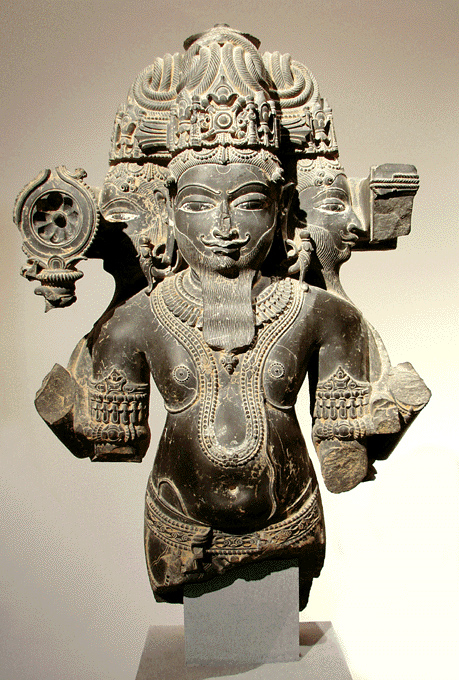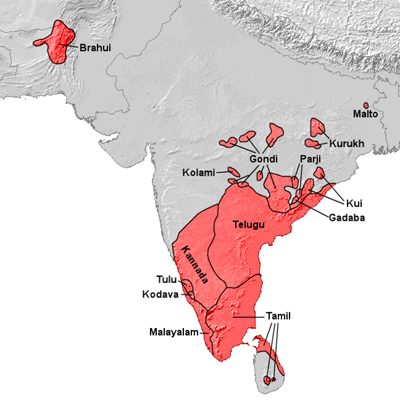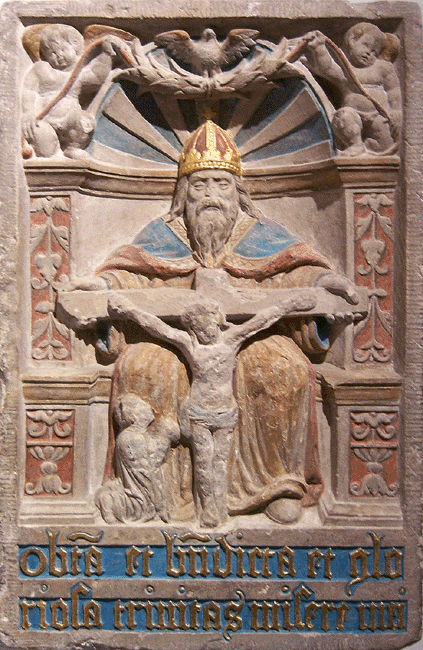
|
|
|
|
Among the northern Dravidian tribes is a group known as the Brahui people, who lived in the Balochistan province of what is now Pakistan. There is also evidence that the Brahui migrated further west into Afghanistan, mixing with the early Afghan Jews. A description of the diaspora of ancient Afghan can be found here.
There are numerous theories on the circumstances under which Brahmans of northern India traveled into Persia (the Iranian plateau comprising today's Iran and Afghanistan) and further into the Middle East. One study by Gene D. Matlock, entitled "Who Was Abraham?", provides an interesting summary of evidence indicating that Lord Brahma was the source of the father of the Judeo-Christian religion, Abrahma (Brahma=Abram). Below we present excerpts from his paper, beginning with a passage quoted from the book Moisés y los Extraterrestres by Mexican author, Tomás Doreste:
"Voltaire was of the opinion that Abraham descended from some of the numerous Brahman priests who left India to spread their teachings throughout the world; and in support of his thesis he presented the following elements: the similarity of names and the fact that the city of Ur, land of the patriarchs, was near the border of Persia, the road to India, where that Brahman had been born.
The name of Brahma was highly respected in India, and his influence spread throughout Persia as far as the lands bathed by the rivers Euphrates and Tigris. The Persians adopted Brahma and made him their own. Later they would say that the God arrived from Bactria, a mountainous region situated midway on the road to India. (pp. 46-47.)
Bactria (a region of ancient Afghanistan) was the locality of a prototypical Jewish nation called Juhuda or Jaguda, also called Ur-Jaguda. Ur meant "place or town." Therefore, the bible was correct in stating that Abraham came from "Ur of the Chaldeans." "Chaldean," more correctly Kaul-Deva (Holy Kauls), was not the name of a specific ethnicity but the title of an ancient Hindu Brahmanical priestly caste who lived in what are now Afghanistan, Pakistan, and the Indian state of Kashmir.
"The tribe of Ioud or the Brahmin Abraham, was expelled from or left the Maturea of the kingdom of Oude in India and, settling in Goshen, or the house of the Sun or Heliopolis in Egypt, gave it the name of the place which they had left in India, Maturea." (Anacalypsis; Vol. I, p. 405.)
"He was of the religion or sect of Persia, and of Melchizedek."(Vol. I, p. 364.) "The Persians also claim Ibrahim, i.e. Abraham, for their founder, as well as the Jews. Thus we see that according to all ancient history the Persians, the Jews, and the Arabians are descendants of Abraham.(p.85) ...We are told that Terah, the father of Abraham, originally came from an Eastern country called Ur, of the Chaldees or Culdees, to dwell in a district called Mesopotamia. Some time after he had dwelt there, Abraham, or Abram, or Brahma, and his wife Sara or Sarai, or Sara-iswati, left their father's family and came into Canaan. The identity of Abraham and Sara with Brahma and Saraiswati was first pointed out by the Jesuit missionaries."(Vol. I; p. 387.)"
"There are certain striking similarities between the Hindu god Brahma and his consort Saraisvati, and the Jewish Abraham and Sarai, that are more than mere coincidences. Although in all of India there is only one temple dedicated to Brahma, this cult is the third largest Hindu sect. In his History of the Jews, the Jewish scholar and theologian Flavius Josephus (37 - 100 A.D.), wrote that the Greek philosopher Aristotle had said: "...These Jews are derived from the Indian philosophers; they are named by the Indians Calani." (Book I:22.) Clearchus of Soli wrote, "The Jews descend from the philosophers of India. The philosophers are called in India Calanians and in Syria Jews. The name of their capital is very difficult to pronounce. It is called 'Jerusalem.'" "Megasthenes, who was sent to India by Seleucus Nicator, about three hundred years before Christ, and whose accounts from new inquiries are every day acquiring additional credit, says that the Jews 'were an Indian tribe or sect called Kalani...'" (Anacalypsis, by Godfrey Higgins, Vol. I; p. 400.) Martin Haug, Ph.D., wrote in The Sacred Language, Writings, and Religions of the Parsis, "The Magi are said to have called their religion Kesh-î-Ibrahim.They traced their religious books to Abraham, who was believed to have brought them from heaven." (p. 16.) The Rig-Veda alludes to Saraswati as being mother, wife, sister and daughter, and elsewhere there are references to Saraswati as Brahma's half-sister, understood to mean ''born of Brahma', the Creator. Mr. Matlock continues: "The bible gives two stories of Abraham. In this first version, Abraham told Pharaoh that he was lying when he introduced Sarai as his sister. In the second version, he also told the king of Gerar that Sarai was really his sister. However, when the king scolded him for lying, Abraham said that Sarai was in reality both his wife and his sister! "...and yet indeed she is my sister; she is the daughter of my father, but not the daughter of my mother; and she became my wife." (Genesis 20:12.) But the anomalies don't end here. In India, a tributary of the river Saraisvati is Ghaggar. Another tributary of the same river is Hakra. According to Jewish traditions, Hagar was Sarai's maidservant; the Moslems say she was an Egyptian princess. Notice the similarities of Ghaggar, Hakra and Hagar.
A third mini-version of the Abraham story turns him into anoher "Noah." We know that a flood drove Abraham out of India. "...Thus saith the Lord God of Israel, your fathers dwelt on the other side of the flood in old time, Even Terah, the father of Abraham, and the father of Nachor; and they served other gods. And I took your father Abraham from the other side of the flood, and led him throughout all the land of Canaan." (Joshua 24:2-3.) Genesis 25 mentions some descendants of his concubine Ketura (Note: The Moslems claim that Ketura is another name of Hagar.): Jokshan; Sheba; Dedan; Epher. Some descendants of Noah were Joktan, Sheba, Dedan, and Ophir. These varying versions have caused me to suspect that the writers of the bible were trying to unite several different branches of Judaism. About 1900 BC, the cult of Brahm was carried to the Middle and Near East by several different Indian groups after a severe rainfall and earthquake tore Northern India apart, even changing the courses of the Indus and Saraisvati rivers. The classical geographer Strabo tells us just how nearly complete the abandonment of Northwestern India was. "Aristobolus says that when he was sent upon a certain mission in India, he saw a country of more than a thousand cities, together with villages, that had been deserted because the Indus had abandoned its proper bed." (Strabo's Geography, XV.I.19.) "The drying up of the Sarasvati around 1900 BCE, which led to a major relocation of the population centered around in the Sindhu and the Sarasvati valleys, could have been the event that caused a migration westward from India. It is soon after this time that the Indic element begins to appear all over West Asia, Egypt, and Greece." (Indic Ideas in the Graeco-Roman World, by Subhash Kak, taken from IndiaStar online literary magazine; p.14) Indian historian Kuttikhat Purushothama Chon believes that Abraham was driven out of India. He states that the Aryans, unable to defeat the Asuras (The mercantile caste that once ruled in the Indus Valley or Harappans) spent so many years fighting covertly against the Asuras, such as destroying their huge system of irrigation lakes, causing destructive flooding, that Abraham and his kindred just gave up and marched to West Asia. (See Remedy the Frauds in Hinduism.) Therefore, besides being driven out of Northern India by floods, the Aryans also forced Indian merchants, artisans, and educated classes to flee to West Asia. "The Arabian historians contend that Brahma and Abraham, their ancestor, are the same person. The Persians generally called Abraham Ibrahim Zeradust. Cyrus considered the religion of the Jews the same as his own. The Hindoos must have come from Abraham, or the Israelites from Brahma..." (Anacalypsis; Vol. I, p. 396.) "...the Temple of Mecca was founded by a colony of Brahmins from India.it was a sacred place before the time of Mohamed, and.they were permitted to make pilgrimages to it for several centuries after his time. Its great celebrity as a sacred place long before the time of the prophet cannot be doubted." (Anacalypsis, Vol. I, p. 421.) "...the city of Mecca is said by the Brahmins, on the authority of their old books, to have been built by a colony from India; and its inhabitants from the earliest era have had a tradition that it was built by Ishmael, the son of Agar. This town, in the Indus language, would be called Ishmaelistan." (Ibid, p. 424.)
| |


